Investigation of Axial Tensile Fracture Performance of Recycled Brick Coarse Aggregate Concrete Using a Cohesion Model
Abstract
:1. Introduction
- (i)
- Answer the question of how the replacement rate of RBCA impacts the tensile strength of concrete
- (ii)
- Analyze the influence of pore structure, including porosity, pore size, and pore shape, on the tensile performance of RC.
- (iii)
- Investigate whether the interfacial transition zone (ITZ) strength, the mortar strength, and the volume fraction of brick aggregate in concrete with full RBCA replacement affect the tensile strength of concrete.
2. Establishment of the Cohesion Zone Model
2.1. Microscale Multiphase Models
2.2. Zero-Thickness Cohesion Interface Elements
2.3. Model Constitutive
2.4. Fracture Criterion
3. Simulation Parameters
4. Analysis and Discussion
4.1. Impact of Brick Aggregate RR and Aggregate Distribution on the Tensile Fracture of RBCA Concrete
4.2. Impact of the Mortar Strength on the Tensile Fracture of RBCA Concrete
4.3. Impact of Pore Structure on the Tensile Fracture of RBCA Concrete
4.4. Impact of the ITZ Strength between Brick Aggregates and Mortar on the Tensile Fracture of Concrete
4.5. Impact of the Brick Coarse Aggregate Volume Fraction on the Tensile Fracture of Concrete
5. Conclusions
- (1)
- As the replacement rate of RBCA increases, the tensile strength and elastic modulus of RC gradually decrease, and the proportion of the crack length passing through the brick aggregates relative to the total crack length increases. Under the same conditions, the distribution location of the different material phases has a minimal impact on the elastic modulus of the recycled brick aggregates but significantly affects the direction of crack propagation.
- (2)
- The tensile properties of RBCA concrete are greatly influenced by low-strength mortar; however, excessively increasing the mortar’s strength does not significantly enhance the tensile properties of RBCA concrete. The effect of the pore structure on the tensile properties of RBCA concrete should not be ignored during the simulation. Increasing porosity and pore size will reduce both the elastic modulus and tensile strength of RBCA concrete.
- (3)
- Increasing the pore size at the same porosity level results in a splitting crack shape. When the pore size is ≥2 mm, the number of non-intersecting cracks is only related to the location of the pores and aggregates. Compared with circular and elliptical pores (with a minor to the major axis of 0.6), convex polygonal pores have the most significant impact on RC. When the ratio of the minor to the major axis (K) of elliptical pores is [0, 1), the tensile strength of RC is inversely proportional to K.
- (4)
- The ITZ strength between brick aggregates and mortar is a key factor in controlling the tensile properties of RC. As the ITZ strength gradually increases, the tensile strength of RC monotonically increases. However, excessively reducing the ITZ strength significantly weakens the tensile properties of RC, while excessively increasing the ITZ strength has a relatively smaller increment in the tensile strength of RC.
- (5)
- With the increase in the volume fraction of brick aggregates, the tensile strength and elastic modulus of RBCA concrete gradually decrease. When the volume fraction of aggregates increases from 20% to 50%, the minimum reduction in elastic modulus is about 0.74%, which has a greater impact on the tensile strength of RBCA concrete than on its elastic modulus.
Author Contributions
Funding
Institutional Review Board Statement
Informed Consent Statement
Data Availability Statement
Conflicts of Interest
References
- Wu, B.; Yu, Y.; Chen, Z.P.; Zhao, X.L. Shape effect on compressive mechanical properties of compound concrete containing demolished concrete lumps. Constr. Build. Mater. 2018, 187, 50–64. [Google Scholar] [CrossRef]
- Gong, Y. Study on Emission Inventory of Atmospheric Pollutants and CO2 and Emission Reduction Cost of Cement Industry in China; Zhejiang University: Zhejiang, China, 2020. [Google Scholar]
- Seror, N.; Portnov, B.A. Estimating the effectiveness of different environmental law enforcement policies on illegal C&D waste dumping in Israel. Waste Manag. 2020, 102, 241–248. [Google Scholar] [PubMed]
- Xiao, J.; Ma, Z.; Ding, T. Reclamation chain of waste concrete: A case study of Shanghai. Waste Manag. 2016, 48, 334–343. [Google Scholar] [CrossRef] [PubMed]
- Alexandridou, C.; Angelopoulos, G.N.; Coutelieris, F.A. Mechanical and durability performance of concrete produced with recycled aggregates from Greek construction and demolition waste plants. J. Clean. Prod. 2018, 176, 745–757. [Google Scholar] [CrossRef]
- GB/T 25177-2010; Recycled Coarse Aggregate for Concrete. Standards Press of China: Beijing, China, 2011.
- GB/T 25176-2010; Recycled Fine Aggregate for Concrete and Mortar. Standards Press of China: Beijing, China, 2011.
- Mefteh, H.; Kebaïli, O.; Oucief, H. Influence of moisture conditioning ofrecycled aggregates on the properties of fresh and hardened concrete. J. Clean. Prod. 2013, 54, 282–288. [Google Scholar] [CrossRef]
- Adessina, A.; Fraj, A.B.; Barthélémy, J.F.; Chateau, C.; Garnier, D. Experimental and micromechanical investigation on the mechanical and durability properties of recycled aggregates concrete. Cem. Concr. Res. 2019, 126, 105900. [Google Scholar] [CrossRef]
- Etxeberria, M.; Marí, A.R.; Vázquez, E. Recycled aggregate concreteas structural material. Mater. Struct. 2007, 40, 529–541. [Google Scholar] [CrossRef]
- Pacheco, J.; De Brito, J.; Chastre, C.; Evangelista, L. Experimental investigation on the variability of the main mechanical properties of concrete produced with coarse recycled concrete aggregates. Constr. Build. Mater. 2019, 201, 110–120. [Google Scholar] [CrossRef]
- Cai, X.; Wu, K.; Huang, W.; Yu, J.; Yu, H. Application of recycled concrete aggregates and crushed bricks on permeable concrete road base. Road Mater. Pavement Des. 2021, 22, 2181–2196. [Google Scholar] [CrossRef]
- Poon, C.S.; Chan, D. Feasible use of recycled concrete aggregates and crushed clay brick as unbound road sub-base. Constr. and Build. Mater. 2006, 20, 578–585. [Google Scholar] [CrossRef]
- Liu, X.; Wu, J.; Zhao, X.; Yan, P.; Ji, W. Effect of brick waste content on mechanical properties of mixed recycled concrete. Constr. Build. Mater. 2021, 292, 123320. [Google Scholar] [CrossRef]
- Yang, J.; Du, Q.; Bao, Y. Concrete with recycled concrete aggregate and crushed clay bricks. Constr. Build. Mater. 2011, 25, 1935–1945. [Google Scholar] [CrossRef]
- Xu, L.; Su, W.; Su, T. Influence of recycled clay brick aggregate on the mechanical properties of concrete. Rev. Adv. Mater. Sci. 2022, 61, 372–380. [Google Scholar] [CrossRef]
- Dang, J.; Zhao, J.; Dai Pang, S.; Zhao, S. Durability and microstructural properties of concrete with recycled brick as fine aggregates. Constr. Build. Mater. 2020, 262, 120032. [Google Scholar] [CrossRef]
- Bonifazi, G.; Capobianco, G.; Serranti, S.; Eggimann, M.; Wagner, E.; Di Maio, F.; Lotfi, S. The ITZ in concrete with natural and recycled aggregates: Study of microstructures based on image and SEM analysis. In Proceedings of the 15th Euroseminar on Microscopy Applied to Building Materials, Delft, The Netherlands, 16–19 June 2015; pp. 299–308. [Google Scholar]
- Wu, J.; Zhang, Y.; Zhu, P.; Feng, J.; Hu, K. Mechanical properties and ITZ microstructure of recycled aggregate concrete using carbonated recycled coarse aggregate. J. Wuhan Univ. Technol.-Mater. Sci. Ed. 2018, 33, 648–653. [Google Scholar] [CrossRef]
- Del Bosque, I.S.; Zhu, W.; Howind, T.; Matías, A.; De Rojas, M.S.; Medina, C. Properties of interfacial transition zones (ITZs) in concrete containing recycled mixed aggregate. Cem. Concr. Compos. 2017, 81, 25–34. [Google Scholar] [CrossRef]
- Yu, Y.; Zheng, Y.; Guo, Y.; Hu, S.; Hua, K. Mesoscale finite element modeling of recycled aggregate concrete under axial tension. Constr. Build. Mater. 2021, 266, 121002. [Google Scholar] [CrossRef]
- Wang, X.F.; Yang, Z.J.; Yates, J.R.; Jivkov, A.P.; Zhang, C. Monte Carlo simulations of mesoscale fracture modelling of concrete with random aggregates and pores. Constr. Build. Mater. 2015, 75, 35–45. [Google Scholar] [CrossRef]
- Jin, L.; Yu, W.; Du, X.; Yang, W. Mesoscopic numerical simulation of dynamic size effect on the splitting-tensile strength of concrete. Eng. Fract. Mech. 2019, 209, 317–332. [Google Scholar] [CrossRef]
- Shi, C.; Shi, Q.; Tong, Q.; Li, S. Peridynamics modeling and simulation of meso-scale fracture in recycled coarse aggregate (RCA) concretes. Theor. Appl. Fract. Mech. 2021, 114, 102949. [Google Scholar] [CrossRef]
- Ding, J.; Wang, X.; Lei, M.; Jiang, K.; Wu, Z. Cohesive element-based chemo-thermo-mechanical multi-field coupled cracking simulation of early-age concrete. Theor. Appl. Fract. Mech. 2024, 130, 104296. [Google Scholar] [CrossRef]
- Peng, H.; Qian, N.; Yin, D.; Luo, W. Modeling Interface Damage with Random Interface Strength on Asphalt Concrete Impervious Facings. Materials 2024, 17, 3310. [Google Scholar] [CrossRef] [PubMed]
- Ying, J.; Guo, J. Fracture Behaviour of Real Coarse Aggregate Distributed Concrete under Uniaxial Compressive Load Based on Cohesive Zone Model. Materials 2021, 14, 4314. [Google Scholar] [CrossRef] [PubMed]
- Wang, J.; Jivkov, A.P.; Engelberg, D.L.; Li, Q. Image-Based vs. Parametric Modelling of Concrete Meso-Structures. Materials 2022, 15, 704. [Google Scholar] [CrossRef] [PubMed]
- Zheng, Z.; Wei, X. Mesoscopic models and numerical simulations of the temperature field and hydration degree in early-age concrete. Constr. Build. Mater. 2021, 266, 121001. [Google Scholar] [CrossRef]
- Yongjun, L.; Zengpeng, Z.; Xin, F. Three-dimensional microstructural simulation of the thermodynamic behavior of recycled concrete under freeze-thaw action. J. Build. Eng. 2023, 80, 108099. [Google Scholar]
- Wittmann, F.H.; Roelfstra, P.E.; Sadouki, H. Simulation and analysis of composite structures. Mater. Sci. Eng. 1985, 68, 239–248. [Google Scholar] [CrossRef]
- Walraven, J.C.; Reinhardt, H.W. Theory and experiments on the mechanical behaviour of cracks in plain and reinforced concrete subjected to shear loading. Heron 1981, 26, 5–68. [Google Scholar]
- Ren, Q.; Li, Q.; Yin, Y. Concrete meso-structure characteristics and mechanical property research with numerical methods. Constr. Build. Mater. 2018, 158, 189–197. [Google Scholar] [CrossRef]
- Kosmatka, S.; Kerkhoff, B.; Panarese, W. Design and Control of Concrete Mixtures, 14th ed.; Portland Cement Association: Skokie, IL, USA, 2011. [Google Scholar]
- Wang, Z.M.; Kwan, A.K.H.; Chan, H.C. Mesoscopic study of concrete I: Generation of random aggregate structure and finite element mesh. Comput. Struct. 1999, 70, 533–544. [Google Scholar] [CrossRef]
- Caballero, A.; López, C.M.; Carol, I. 3D meso-structural analysis of concrete specimens under uniaxial tension. Comput. Methods Appl. Mech. Eng. 2006, 195, 7182–7195. [Google Scholar] [CrossRef]
- Hillerborg, A.; Modéer, M.; Petersson, P.E. Analysis of crack formation and crack growth in concrete by means of fracture mechanics and finite elements. Cem. Concr. Res. 1976, 6, 773–781. [Google Scholar] [CrossRef]
- Benzeggagh, M.L.; Kenane, M. Measurement of mixed-mode delamination fracture toughness of unidirectional glass/epoxy composites with mixed-mode bending apparatus. Compos. Sci. Technol. 1996, 56, 439–449. [Google Scholar] [CrossRef]
- Yi, X. Experimental Study on the Uniaxial Tensile Constitutive Relationship of Concrete under High Strain Rate; Hebei University of Technology: Tianjin, China, 2010. [Google Scholar]
- Li, W.; Xiao, J.; Sun, Z.; Kawashima, S.; Shah, S.P. Interfacial transition zones in recycled aggregate concrete with different mixing approaches. Constr. Build. Mater. 2012, 35, 1045–1055. [Google Scholar] [CrossRef]
- Wang, H.; Zhai, A.L. Experimental study on the splitting tensile strength of recycled concrete made of brick and tile. Appl. Mech. Mater. 2012, 166, 1521–1525. [Google Scholar] [CrossRef]
- Ji, Y.; Wang, D.; Wang, L. Numerical and Experimental Investigation of Recycled Brick Coarse Aggregate Concrete. Appl. Sci. 2022, 12, 9035. [Google Scholar] [CrossRef]
- Rahman, M.S.; Ahmad, S.I. Strength properties of concrete made from recycled brick concrete and EAF slag blended as coarse aggregate. In Materials Science Forum; Trans Tech Publications Ltd.: Stafa-Zurich, Switzerland, 2020; Volume 984, pp. 207–212. [Google Scholar]
- Cachim, P.B. Mechanical properties of brick aggregate concrete. Constr. Build. Mater. 2009, 23, 1292–1297. [Google Scholar] [CrossRef]
- Odera, B.J.; Mutuku, R.N.; Kabubo, C.K. Mechanical characteristics of normal concrete partially replaced with crushed clay bricks. Int. J. Civ. Eng. Technol. 2015, 6, 62–75. [Google Scholar]
- Abdullah, D.J.; Abbas, Z.K.; Abed, S.K. Some properties of concrete containing waste brick as partial replacement of coarse aggregate and addition of nano brick powder. In IOP Conference Series: Earth and Environmental Science; IOP Publishing: Bristol, UK, 2022; Volume 961, p. 012093. [Google Scholar]
- Kheder, G.F.; Al-Windawi, S.A. Variation in mechanical properties of natural and recycled aggregate concrete as related to the strength of their binding mortar. Mater. Struct. 2005, 38, 701–709. [Google Scholar] [CrossRef]
- Wang, D.; Lu, C.; Zhu, Z.; Zhang, Z.; Liu, S.; Ji, Y.; Xing, Z. Mechanical performance of recycled aggregate concrete in green civil engineering. Case Stud. Constr. Mater. 2023, 19, e02384. [Google Scholar] [CrossRef]
- Wang, X.; Yang, Z.; Jivkov, A.P. Monte Carlo simulations of mesoscale fracture of concrete with random aggregates and pores: A size effect study. Constr. Build. Mater. 2015, 80, 262–272. [Google Scholar] [CrossRef]
- Liu, J.; Ma, K.; Shen, J.; Xie, Y.; Long, G. Influence of CO2 enhancement of recycled aggregate on microstructure of ITZs in recycled concrete. J. Build. Eng. 2023, 65, 105805. [Google Scholar] [CrossRef]
- Fang, G.; Chen, J.; Dong, B.; Liu, B. Microstructure and micromechanical properties of interfacial transition zone in green recycled aggregate concrete. J. Build. Eng. 2023, 66, 105860. [Google Scholar] [CrossRef]
- Gao, S.; Guo, J.; Zhu, Y.; Jin, Z. Study on the influence of the properties of interfacial transition zones on the performance of recycled aggregate concrete. Constr. Build. Mater. 2023, 408, 133592. [Google Scholar] [CrossRef]
- Xiao, J.; Li, W.; Sun, Z.; Lange, D.A.; Shah, S.P. Properties of interfacial transition zones in recycled aggregate concrete tested by nanoindentation. Cem. Concr. Compos. 2013, 37, 276–292. [Google Scholar] [CrossRef]
- Liu, X.; Liu, L.; Lyu, K.; Li, T.; Zhao, P.; Liu, R.; Zuo, J.; Fu, F.; Shah, S.P. Enhanced early hydration and mechanical properties of cement-based materials with recycled concrete powder modified by nano-silica. J. Build. Eng. 2022, 50, 104175. [Google Scholar] [CrossRef]
- Qiu, J.; Wang, J.; Feng, Z.; Xiao, Z.; Li, L. Study on the modification mechanism of recycled brick-concrete aggregate concrete based on water glass solution immersion method. J. Build. Eng. 2024, 82, 108303. [Google Scholar] [CrossRef]
- Uddin, M.T.; Mahmood, A.H.; Kamal, M.R.I.; Yashin, S.M.; Zihan, Z.U.A. Effects of maximum size of brick aggregate on properties of concrete. Constr. Build. Mater. 2017, 134, 713–726. [Google Scholar] [CrossRef]

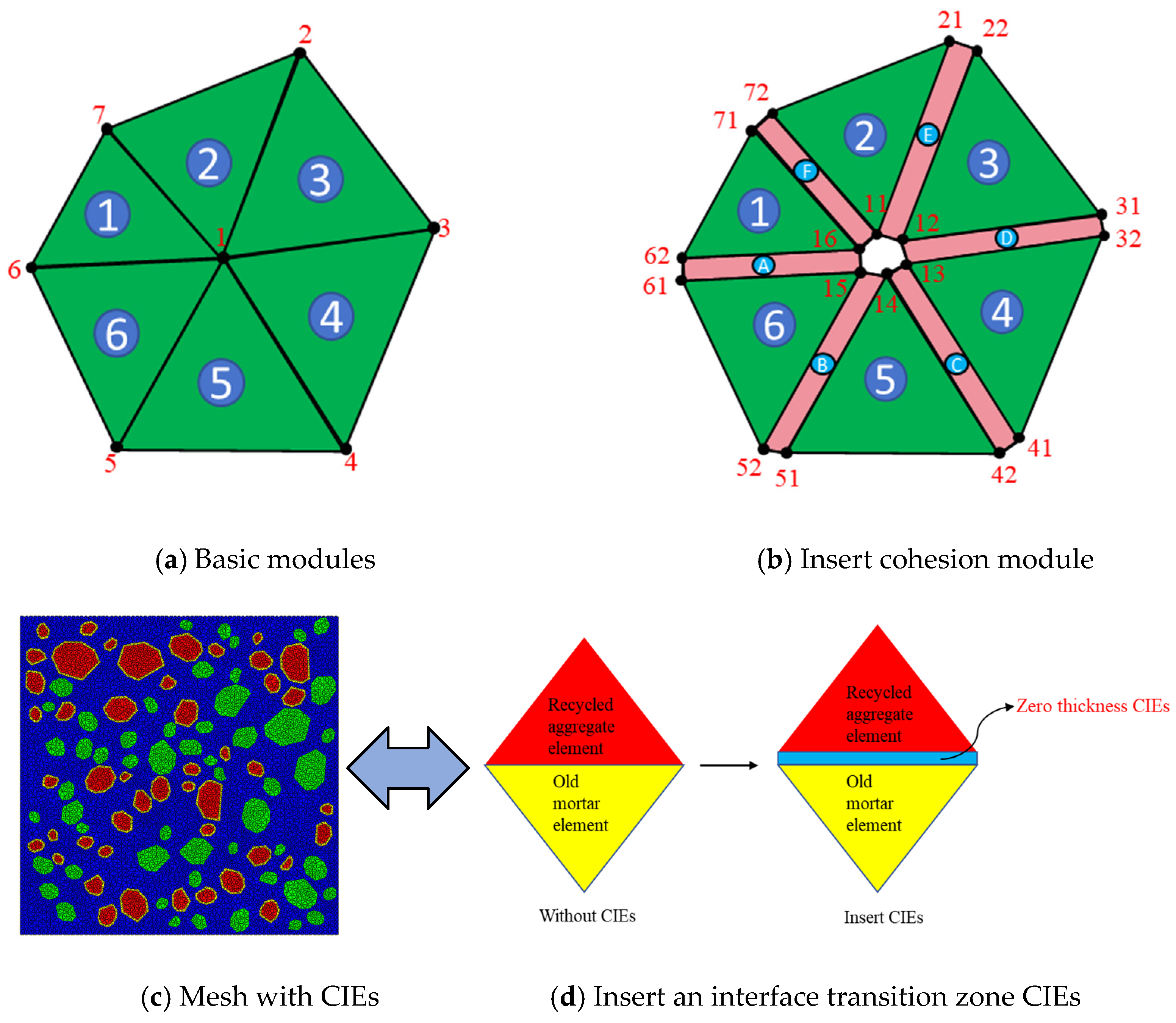
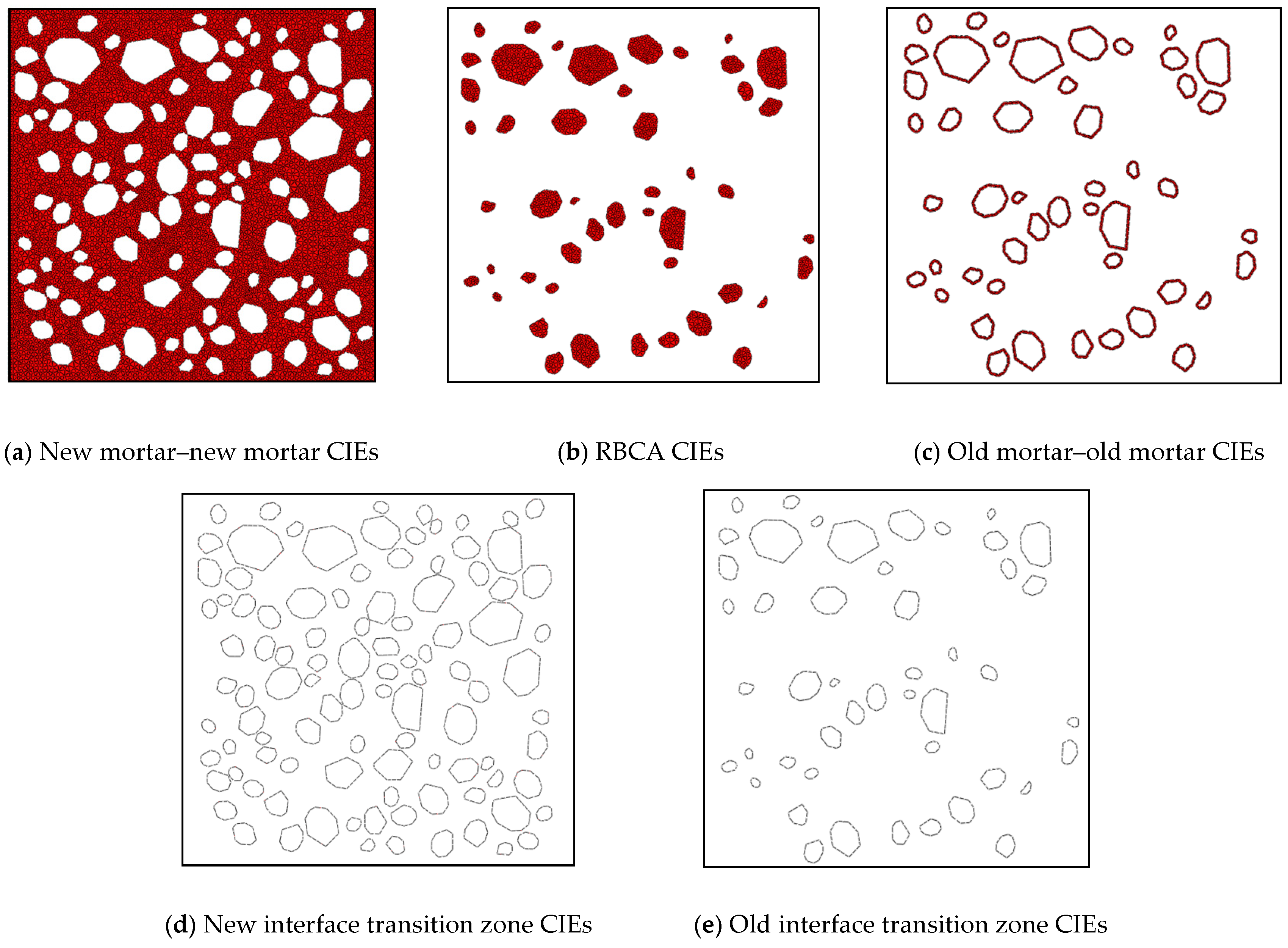
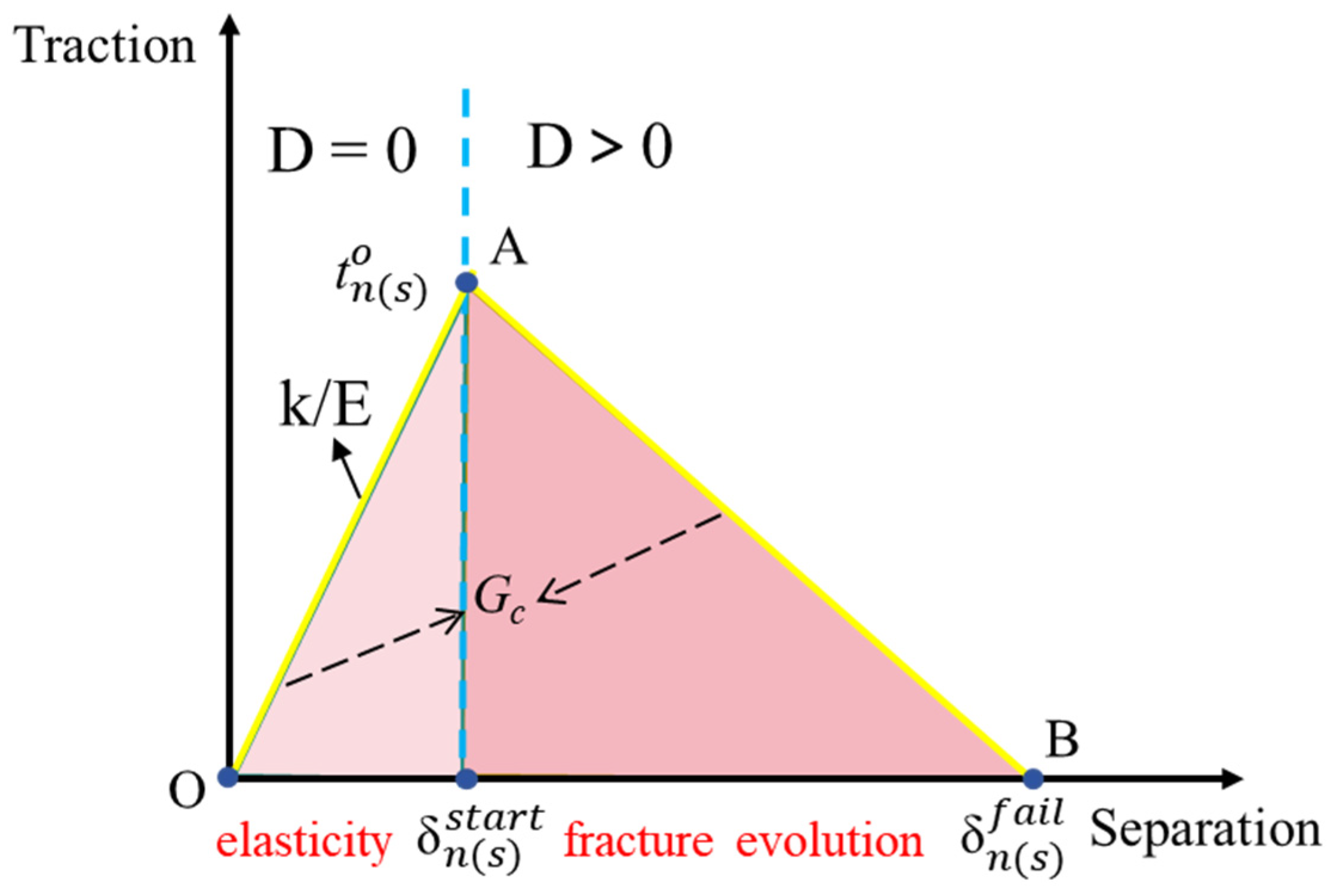


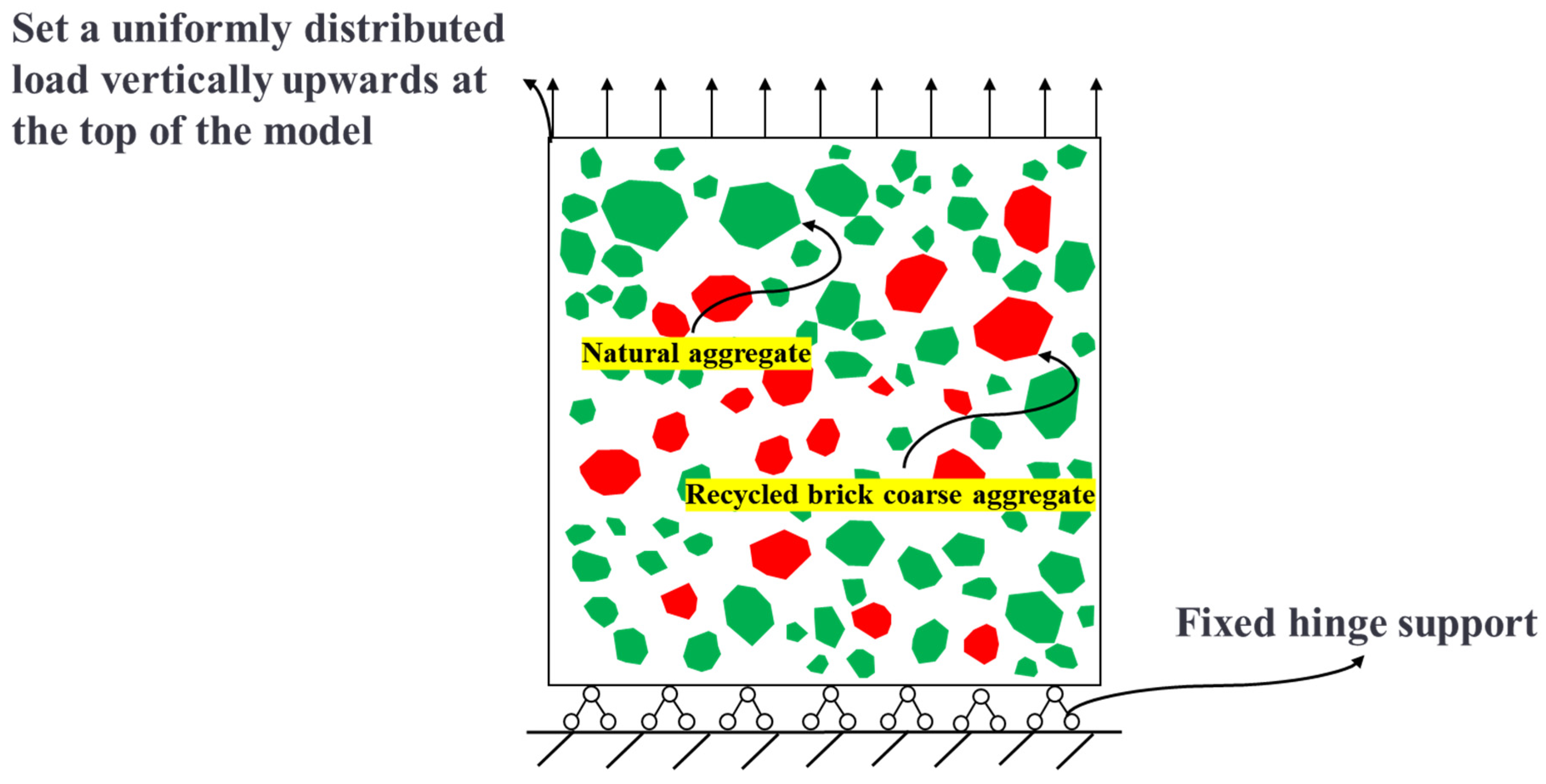
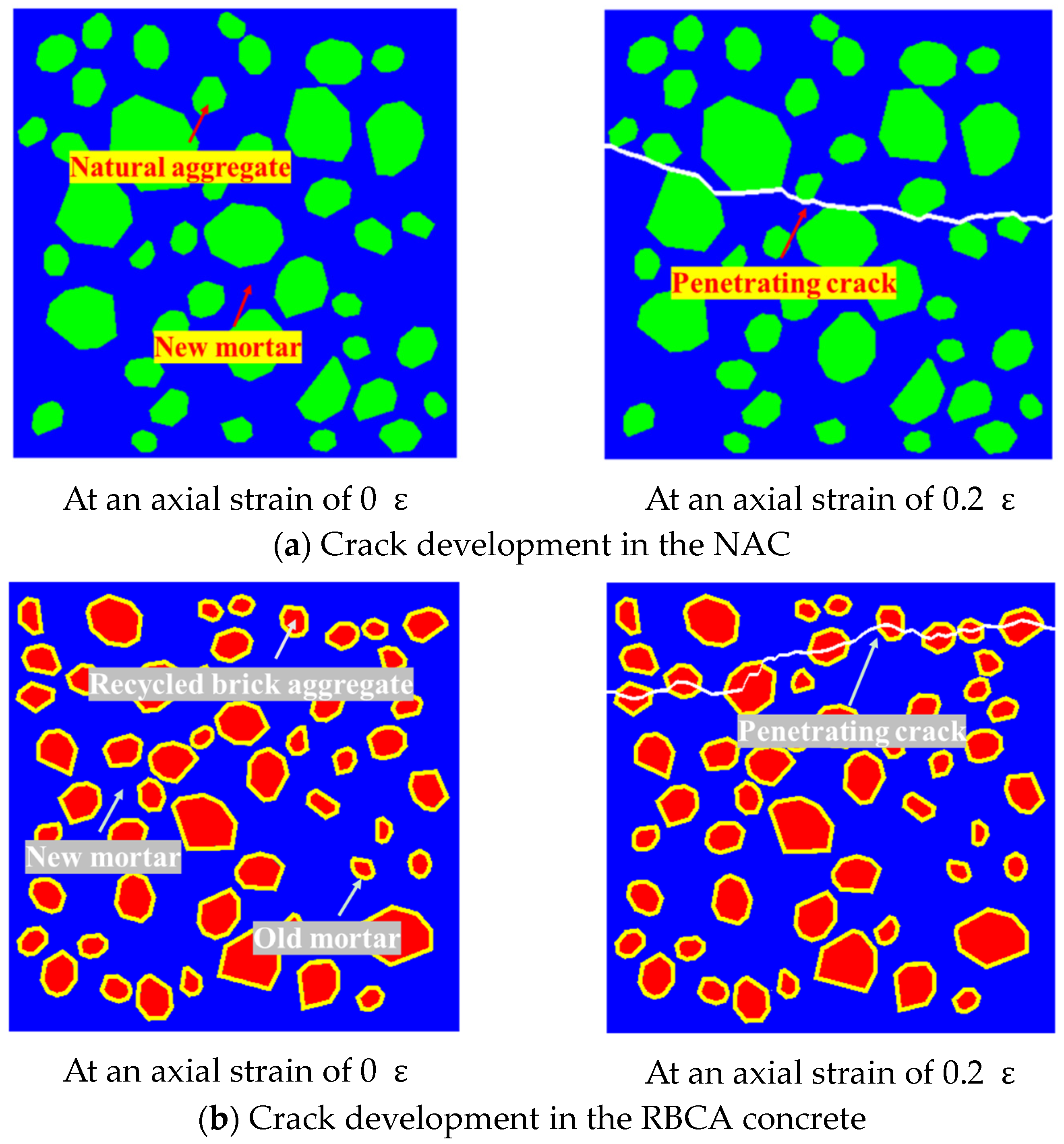
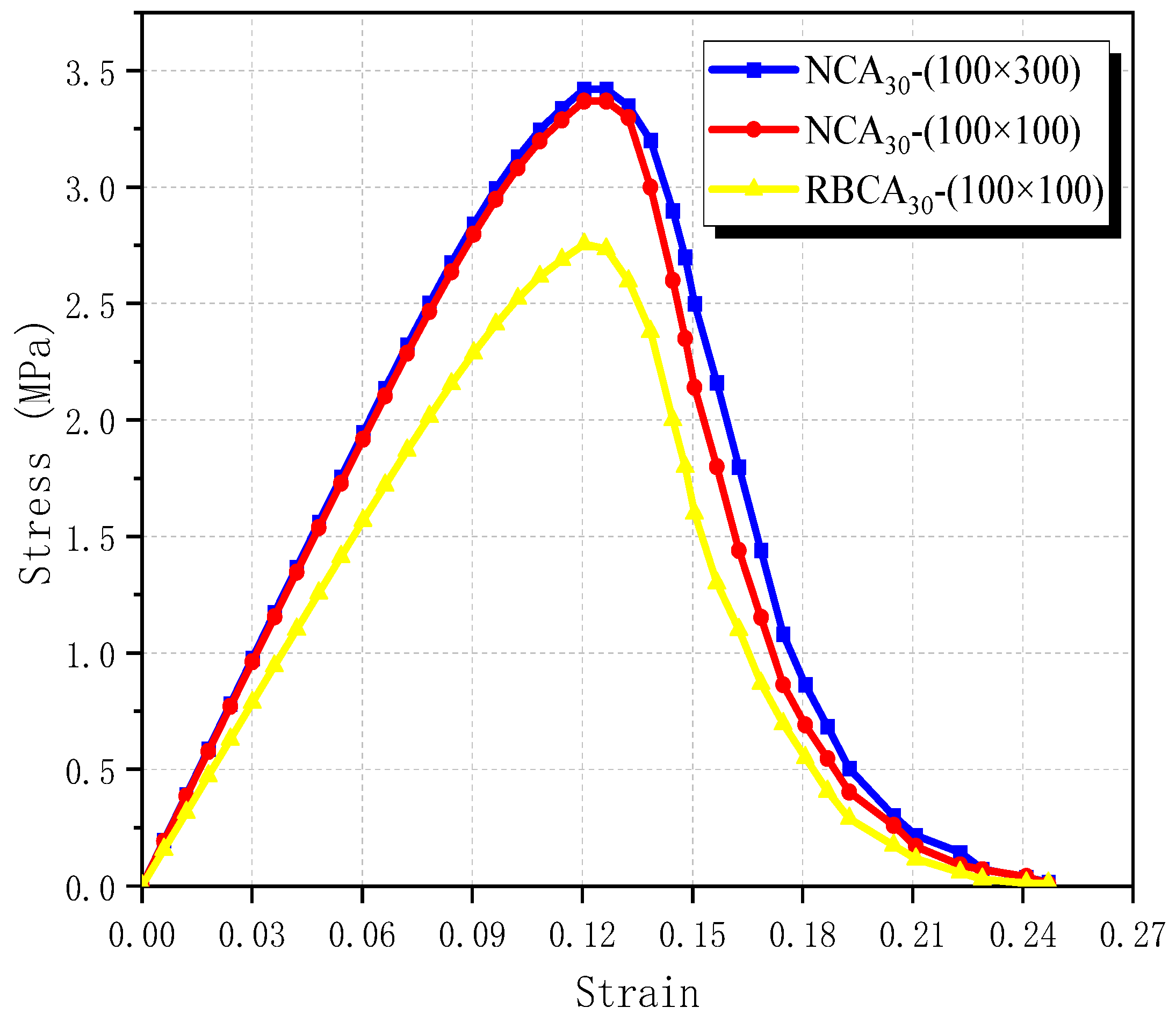


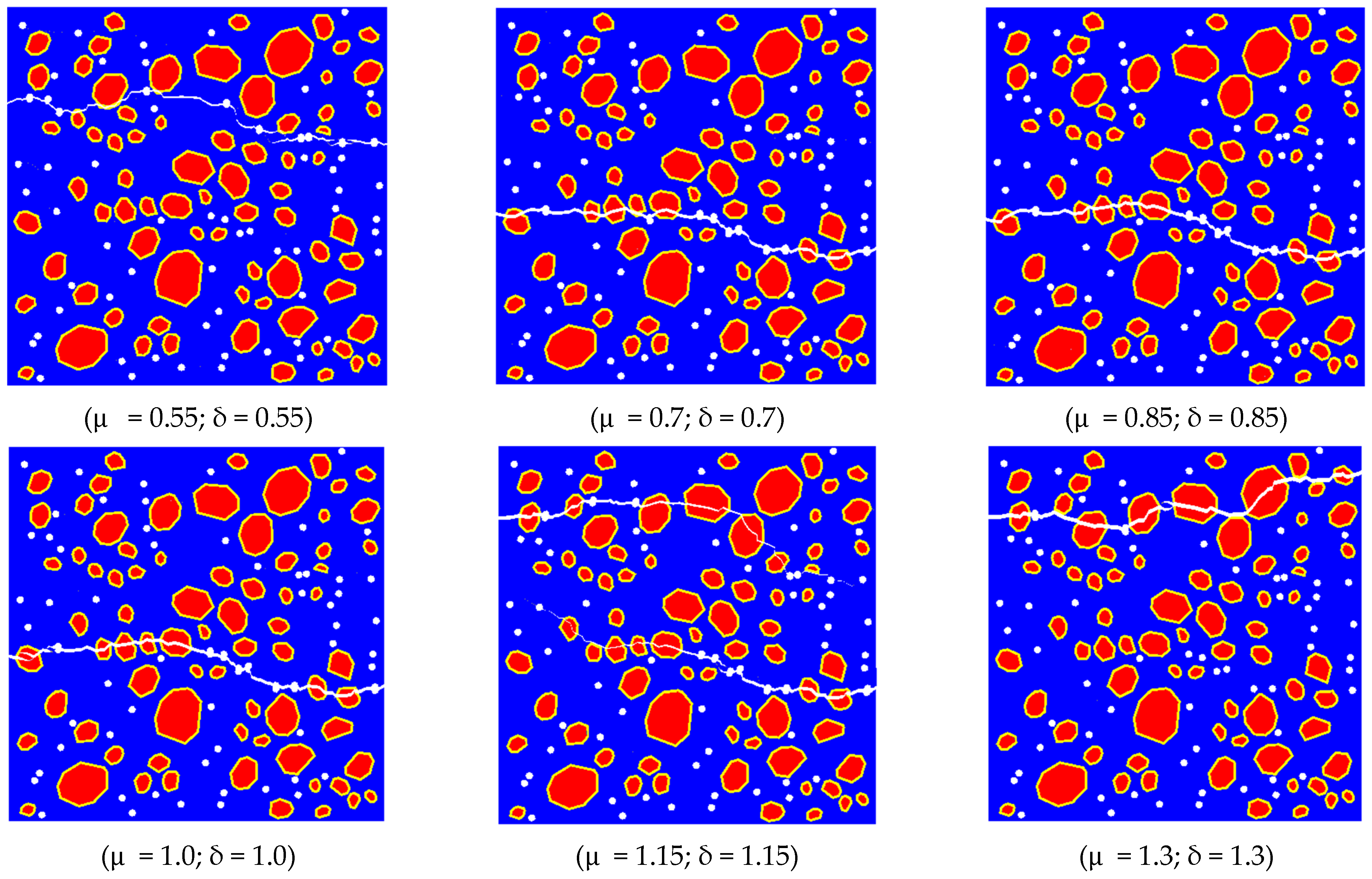





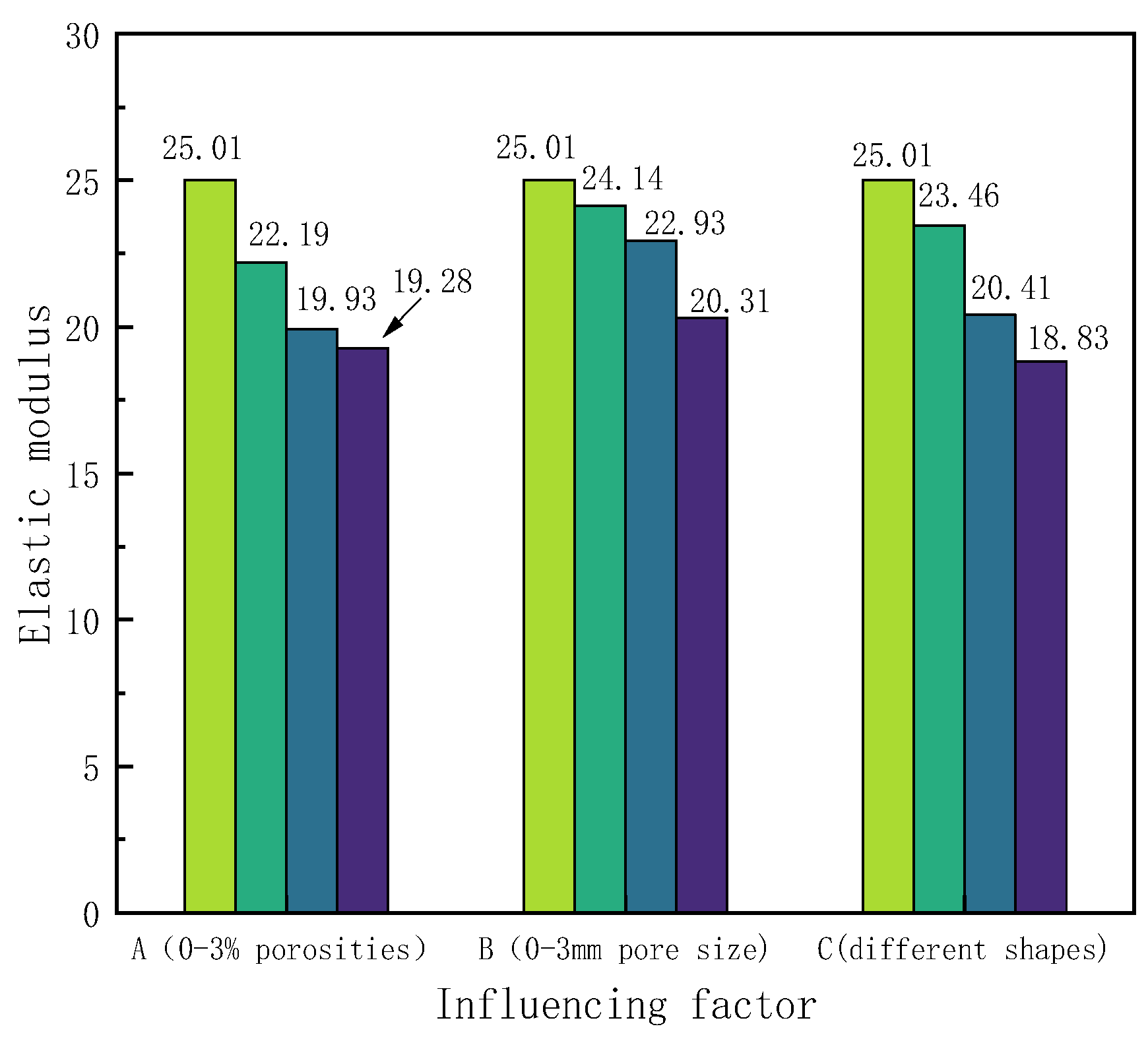
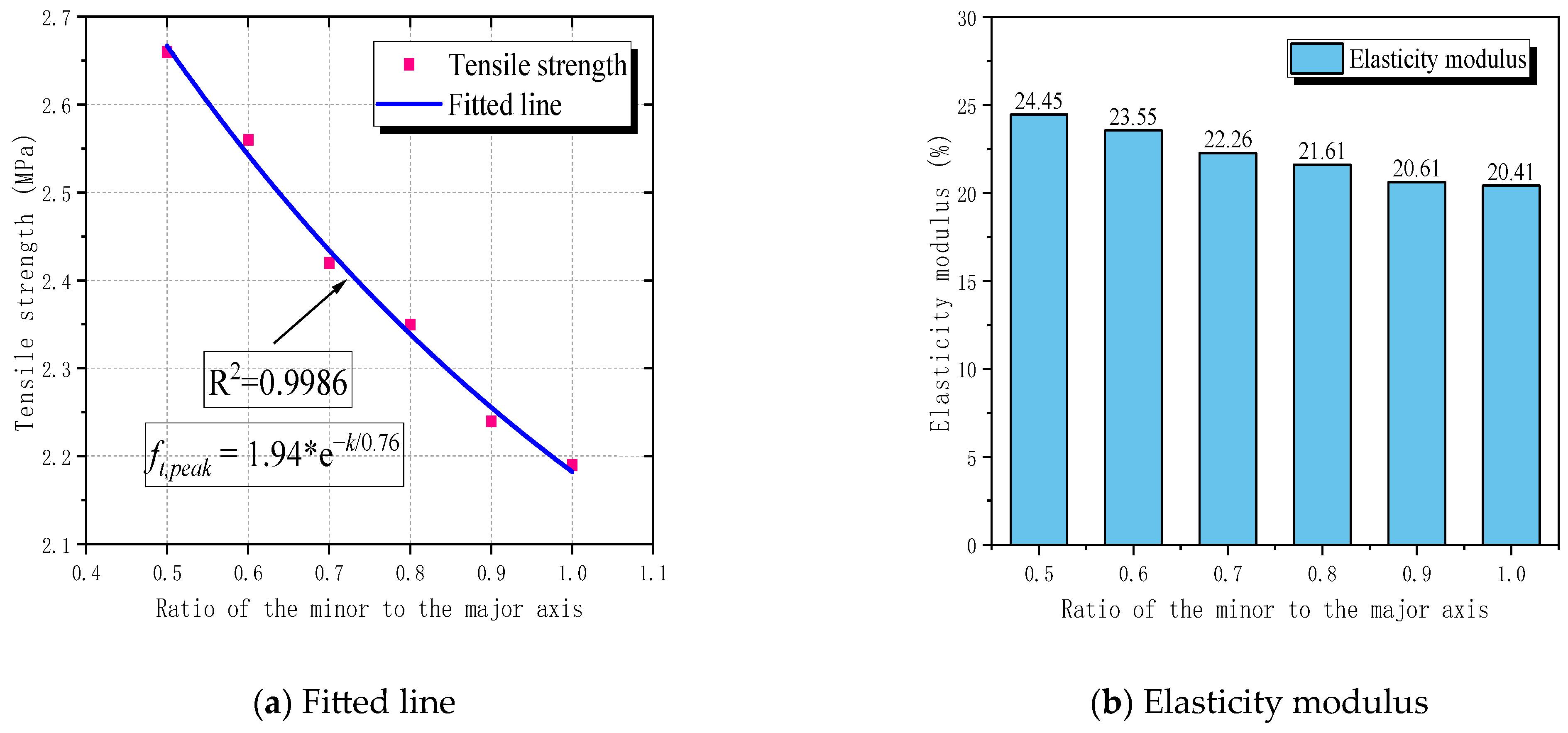
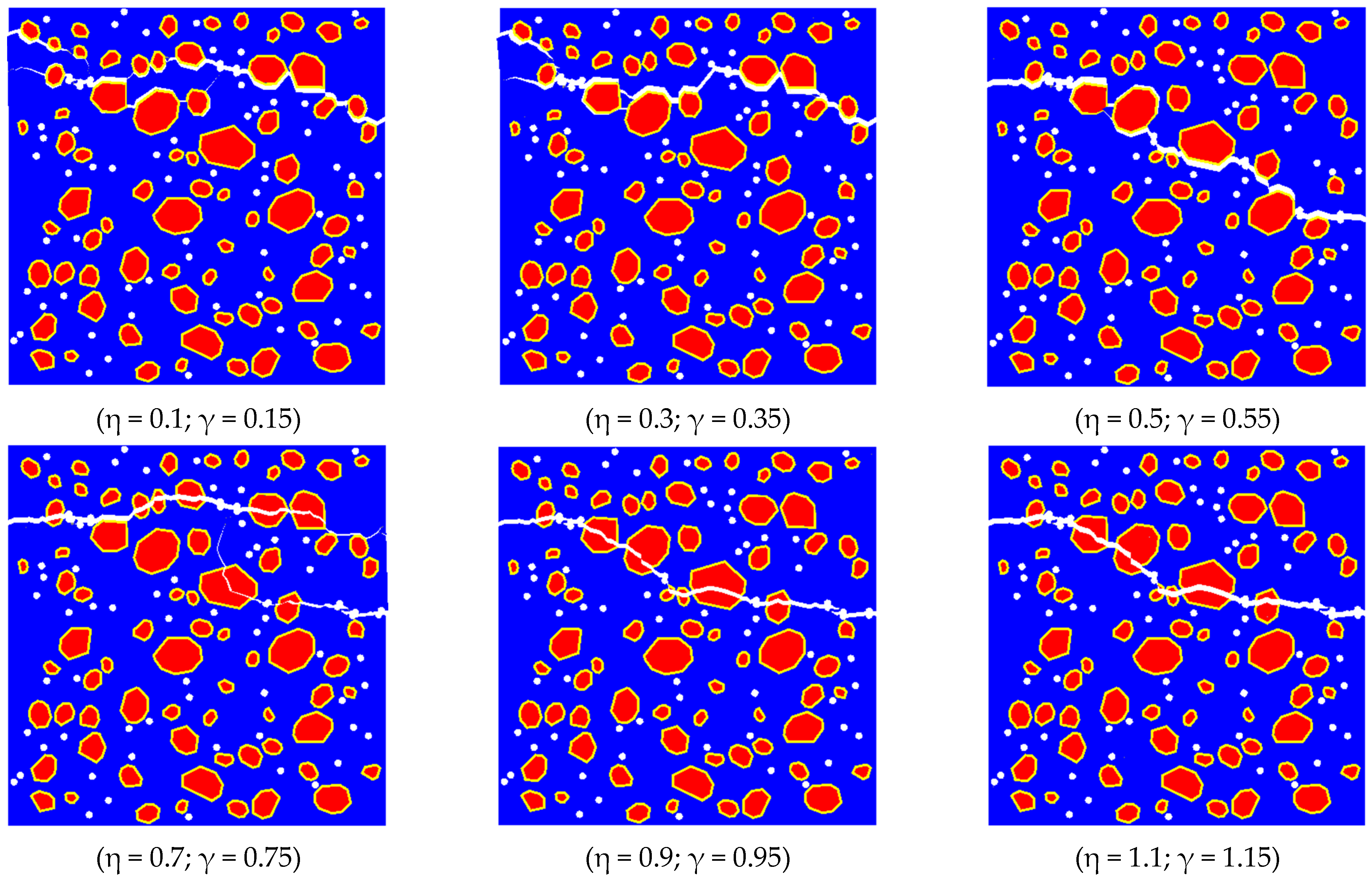
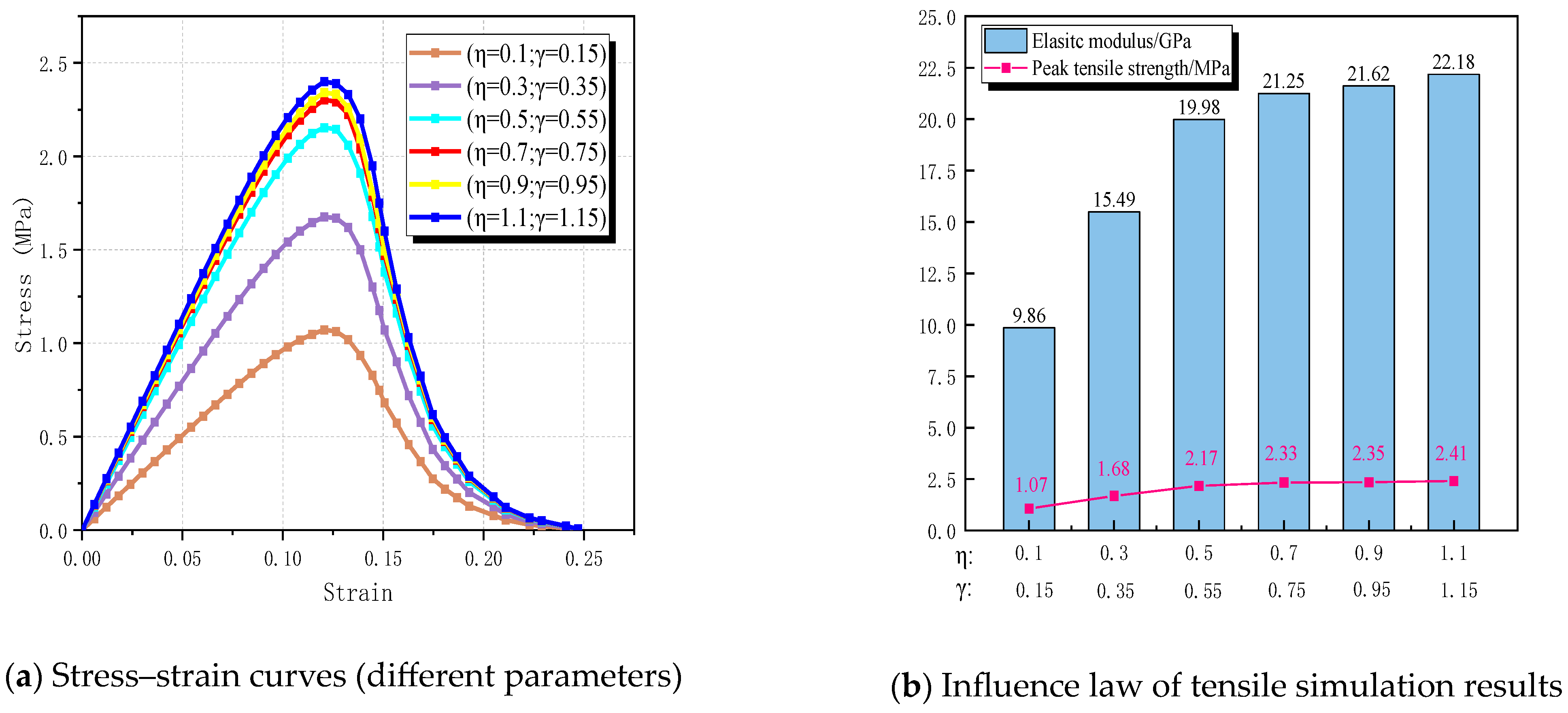
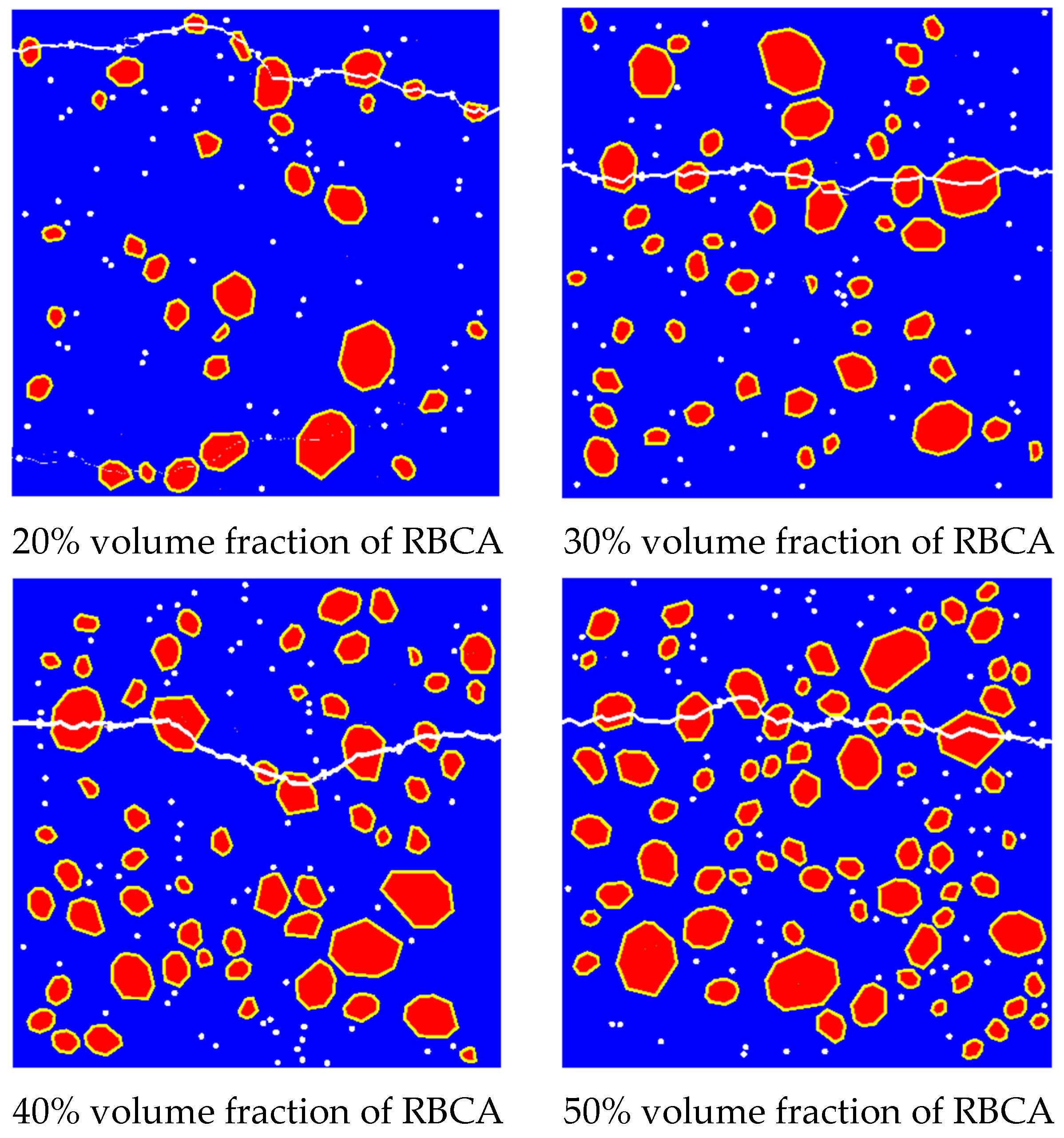
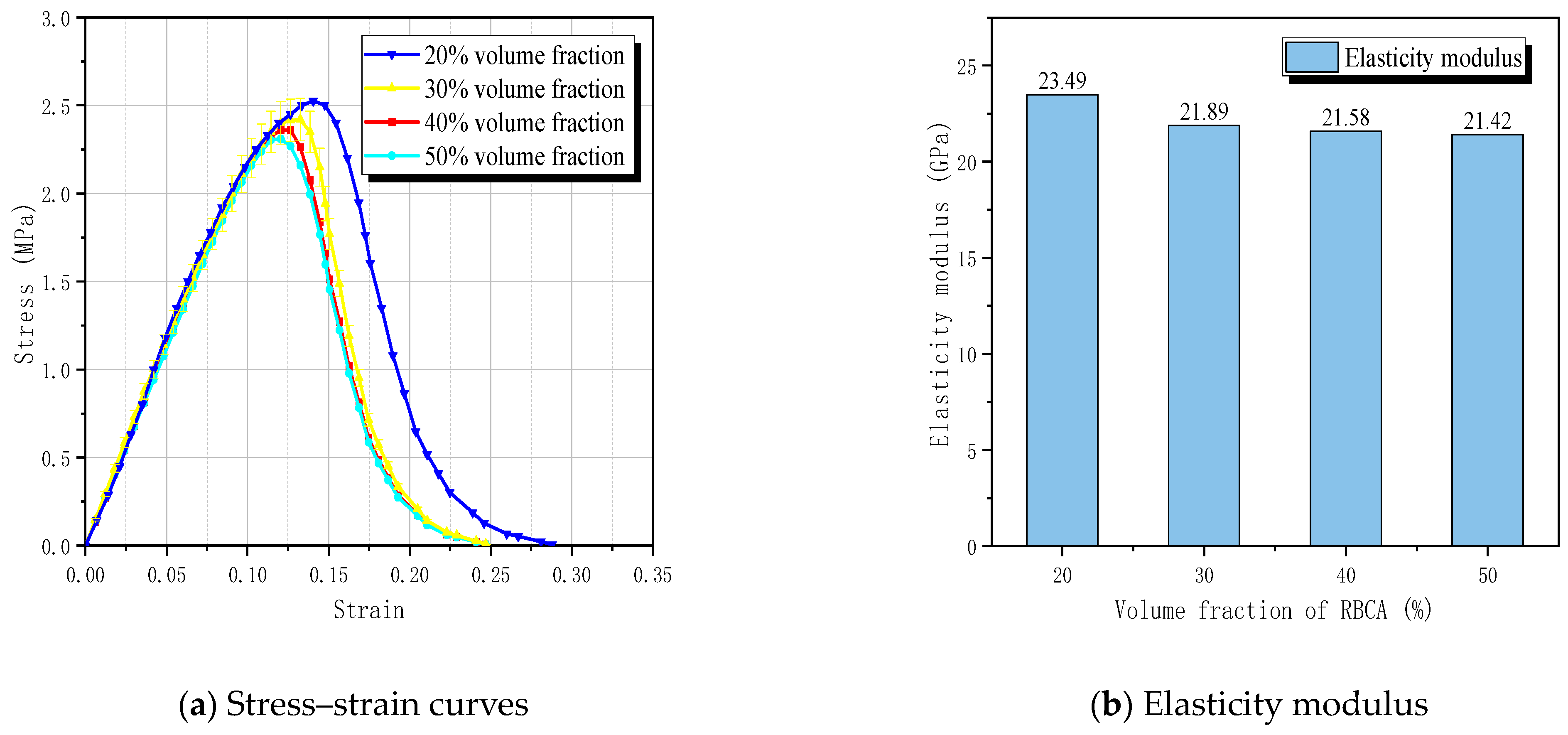
| Average Aggregate Size | NA Distribution Ratio (%) | RA Distribution Ratio (%) |
|---|---|---|
| 0–5 | 30 | 30 |
| 5–10 | 19.51 | 17.7 |
| 10–15 | 13.24 | 15.23 |
| 15–20 | 7.25 | 7.07 |
| Specimen Notation | Water | Cement | Coarse Aggregate | Sand |
|---|---|---|---|---|
| NAC25 | 0.86 | 1 | 4.68 | 4.25 |
| NAC30 | 0.73 | 1 | 4.36 | 3.08 |
| NAC35 | 0.63 | 1 | 3.86 | 2.41 |
| Specimen Notation | Aggregate (E, ν) | Mortar (E, ν) | Mortar–Mortar CIEs | Aggregate–Mortar CIEs |
|---|---|---|---|---|
| NAC25 | (80, 000, 0.16) | (27, 000, 0.25) | (325, 000, 3.25, 0.1) | (325, 000, 2.6, 0.08) |
| NAC30 | (80, 000, 0.16) | (29, 000, 0.25) | (388, 000, 3.88, 0.1) | (348, 750, 2.8, 0.08) |
| NAC35 | (80, 000, 0.16) | (31, 000, 0.25) | (450, 000, 4.50, 0.1) | (450, 000, 3.6, 0.08) |
| NAC35a | (80, 000, 0.16) | (30, 000, 0.25) | (430, 000, 4.30, 0.1) | (412, 500, 3.3, 0.08) |
| NAC35b | (80, 000, 0.16) | (29, 500, 0.25) | (410, 000, 4.10, 0.1) | (387, 500, 3.1, 0.08) |
| Element Type | E | ν | k | ||
|---|---|---|---|---|---|
| NCA | 80,000 | 0.16 | - | - | - |
| RBCA | 17630 | 0.22 | - | - | - |
| New mortar | 29,000 | 0.25 | - | - | - |
| Old mortar | 24,650 | 0.25 | - | - | - |
| RBCA CIEs | - | - | 192,000 | 1.92 | 0.1 |
| NA–New mortar CIEs | - | - | 297,000 | 3.71 | 0.08 |
| RBCA–old mortar CIEs | - | - | 217,600 | 2.72 | 0.08 |
| New mortar–old mortar CIEs | - | - | 288,000 | 2.88 | 0.1 |
| New mortar–New mortar CIEs | - | - | 320,000 | 3.20 | 0.1 |
| Old mortar–Old mortar CIEs | - | - | 272,000 | 2.72 | 0.1 |
Disclaimer/Publisher’s Note: The statements, opinions and data contained in all publications are solely those of the individual author(s) and contributor(s) and not of MDPI and/or the editor(s). MDPI and/or the editor(s) disclaim responsibility for any injury to people or property resulting from any ideas, methods, instructions or products referred to in the content. |
© 2024 by the authors. Licensee MDPI, Basel, Switzerland. This article is an open access article distributed under the terms and conditions of the Creative Commons Attribution (CC BY) license (https://creativecommons.org/licenses/by/4.0/).
Share and Cite
Zeng, Y.; Li, Q.; Yang, Z.; Zhao, Q. Investigation of Axial Tensile Fracture Performance of Recycled Brick Coarse Aggregate Concrete Using a Cohesion Model. Materials 2024, 17, 3630. https://doi.org/10.3390/ma17153630
Zeng Y, Li Q, Yang Z, Zhao Q. Investigation of Axial Tensile Fracture Performance of Recycled Brick Coarse Aggregate Concrete Using a Cohesion Model. Materials. 2024; 17(15):3630. https://doi.org/10.3390/ma17153630
Chicago/Turabian StyleZeng, Yu, Qionglin Li, Zhenchao Yang, and Qilong Zhao. 2024. "Investigation of Axial Tensile Fracture Performance of Recycled Brick Coarse Aggregate Concrete Using a Cohesion Model" Materials 17, no. 15: 3630. https://doi.org/10.3390/ma17153630




